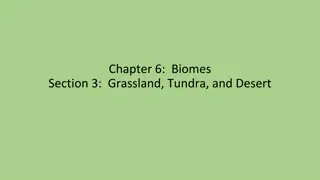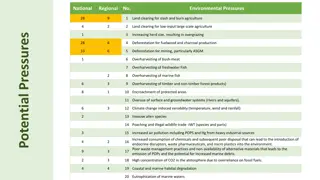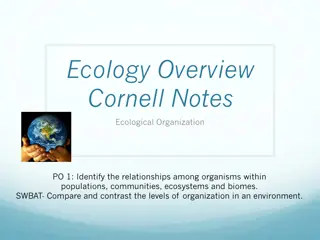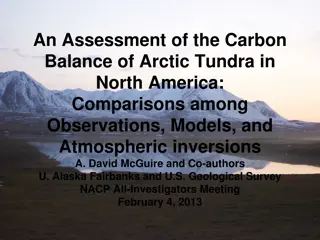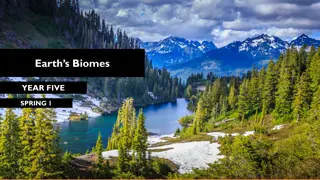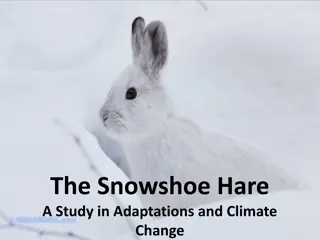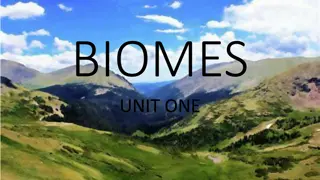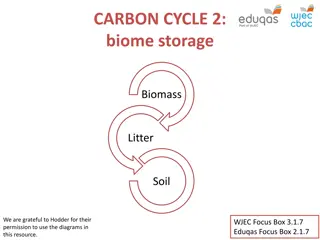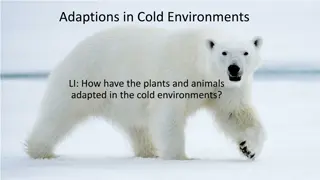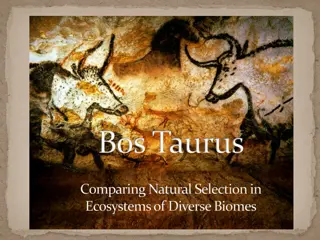Exploring the Tundra and Taiga Biomes
Discover the unique characteristics of the tundra and taiga biomes, from the frozen landscapes of the tundra with its array of adapted plant and animal species to the coniferous forests of the taiga teeming with diverse wildlife. Learn about the extreme climate conditions and fascinating ecosystems that define these biomes.
Download Presentation

Please find below an Image/Link to download the presentation.
The content on the website is provided AS IS for your information and personal use only. It may not be sold, licensed, or shared on other websites without obtaining consent from the author.If you encounter any issues during the download, it is possible that the publisher has removed the file from their server.
You are allowed to download the files provided on this website for personal or commercial use, subject to the condition that they are used lawfully. All files are the property of their respective owners.
The content on the website is provided AS IS for your information and personal use only. It may not be sold, licensed, or shared on other websites without obtaining consent from the author.
E N D
Presentation Transcript
A large geographical area of distinctive plant and animal groups, which are adapted to that particular environment Climate is also a major factor in determining the type of biome
Tundra Taiga Deciduous Forest Grassland Rainforest Desert Aquatic
Occur between 50-70 North, average annual temperature is -18 Farenheit tundra comes from the Finnish word tunturia which means barren land Ground is permanently frozen 10 inches to 3 feet below the surface (called the permafrost) Main seasons are winter and summer in winter, the sun almost never rises, and in summer, it almost never sets!
TUNDRA PLANTS TUNDRA ANIMALS Animals include caribou, musk oxen, arctic foxes, arctic hares, snowy owls, lemmings, wolves, bears, wolverines, mosquitoes, black flies, deer flies, and midges ( no-see-ums ) The tundra is also a good place in summer for migratory birds such as plover, sandpipers, and ducks It is so cold, and the permafrost is so deep that trees can't grow there - the bare ground can only support low growing plants like mosses, heaths, and lichen
The taiga is the coniferous forest and occurs in Northern latitudes Taiga is the Russian word for forest Main seasons are winter and summer it is very cold in winter and warm and humid in the short summer
TAIGA PLANTS TAIGA ANIMALS Because of harsh conditions, few ground plants occur in the tiaga, but lichens and mosses are plentiful Most plants are coniferous trees like pine, white spruce, hemlock and douglas fir. Red deer, elk, moose, wolverines, bobcats, minks, and ermines, lynx, snowshoe hares, squirrels, voles, and plenty of insects Birds of the taiga are either seasonal insect- eaters, or seed-eaters like sparrows and finches and stay all year
Deciduous forests occur on several different contintents These forests have four distinct seasons: spring, summer, autumn, and winter Deciduous forests can have five different zones of plant life: trees, saplings, shrubs, herbs, and a ground zone Animals live in all five of these zones
PLANTS ANIMALS Large mammals can live in the deciduous forest, such as deer, bears, and wolves. Smaller mammals also occur in abundance. Birds include different species of songbirds, mockingbirds, and raptors such as hawks, owls, and eagles Deciduous trees such as oak, maple, elm, walnut, sweetgum, beech, chesnut Other plants include mosses, lichen, huckleberry, blackberry, rhododendrons, etc.
Grasslands are large, rolling terrains of grasses, flowers, and herbs. Species of plants that occur depend on climate, soil type, and latitude. Grasslands have two basic seasons : growing and dormant. These seasons can depend a great deal on rainfall.
GRASSLAND PLANTS GRASSLAND ANIMALS Common mammals living on grasslands in the Americas are prairie dogs, coyotes, small rodents, and bison. Birds can include species of flycatchers, sparrows, wild turkey, quail, grouse, and prairie chickens. Reptiles such as indigo snakes, rattlesnakes, and small lizards live in the grasslands. The most common plants on the North American prairie are buffalo grass, clover, sunflowers, and bluestem grass. Trees rarely occur on grasslands because of naturally occurring wildfires grasses can more easily recover from fires than can trees.
Rainforests are forests of tall trees in a region of year-round warmth Rainfall is often more than 100 inches per year Almost all rainforests lie near the equator Rainforests cover about 6% of the earth s surface and are thought to produce nearly 40% of Earth s oxygen Rainforests have extremely high biodiversity
RAINFOREST PLANTS RAINFOREST ANIMALS 70 % of the plants in a rainforest are trees a rainforest has more types of trees than anywhere else in the world! Insects make up the largest group of animals in the rainforests insects play an important role in plant pollination and nutrient recycling. There are several foliage layers in a rainforest: an emergent layer, upper canopy, understory, shrubs, and the forest floor. Many animals have adaptations for living in trees such as prehensile tails. Plants in the rainforest must have adaptations to deal with large amounts of rainfall, as well as a shallow soil there is only a thin layer of nutritious soil in a rainforest. May birds of the rainforest are brightly colored and have adaptations for being mainly insect and fruit eaters.
A desert is an area that receives less than 20 inches of rain a year There are four major types of deserts: hot and dry, semiarid, coastal, and cold. Desert plants and animals are extremely adapted to deal with the harsh environments of these four types of deserts
DESERT PLANTS DESERT ANIMALS Most desert animals burrow underground and come out at night The most common desert animals are typically reptiles. There are relatively few large mammals in deserts because most are not capable of storing water and withstanding heat. Most desert mammals are small, and will spend the majority of their time burrowing underground. Plants in desert environments are specialized to take in and retain as much water as possible this can be done by having thick, waxy leaves, or by reducing leaf surface area (in plants, leaves typically release water). Desert plant leaves also store nutrients. Many plants in the desert are called cacti, or succulent plants.
Over 75% of Earth is covered in water, making the aquatic biome the largest biome on the planet. The aquatic biome can be broken into two basic regions: freshwater and marine. Aquatic biomes have high biodiversity.
Freshwater is defined as having a low salt concentration less than 1%. Lakes, ponds, streams, rivers, and wetlands are all considered freshwater.
FRESHWATER PLANTS FRESHWATER ANIMALS Freshwater plants can either live completely submerged underwater, or rooted to the bottom and float on the water s surface (these are called emergent or floating plants) Freshwater plants provide a natural filter system for the planet s freshwater and serves as a habitat or food source for many different animals All animals on Earth depend on freshwater in some way Freshwater animals can include insects, fish, reptiles, amphibians, birds and mammals
The marine biome is the biggest biome in the world it covers about 70% of the Earth The marine biome is home to most of Earth s biodiversity The marine biome is also heavily used by humans in medicine, food, and other resources!
MARINE PLANTS Marine algae provide much of the world s oxygen through the process called photosynthesis One type of marine plant is kelp. Others include seaweed and phytoplankton Along coastal areas, some trees are even adapted to growing in salt water Marine plants like kelp, seaweed, salt grass, and mangroves also provide habitats for marine animals to take cover and feed in.
The oceans animals have special adaptations to deal with living in a salt-concentrated environment Marine mammals have a thick layer of blubber to help them regulate body temperature because the oceans are often cold Some animals have adaptations that allow them to travel great distances by surfing the ocean s currents Coral reefs are an amazing marine ecosystem over 25% of all life in the oceans are found in coral reefs!




